3D printing has seen rapid development in recent years and could make a big impact in 2012.
3D printing sounds great, right? You come up with an idea, design it on your computer, and then it gets created right there in front of you.
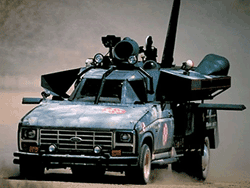
Jet Car from the movie The Adventures of Buckaroo Banzai Across the 8th Dimension .
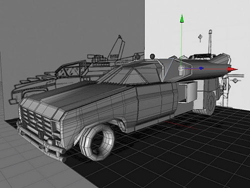
Design stage.
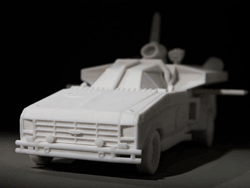
Final product. (All images in series via: popularmechanics.com)
With the continued advancements we’re seeing in this technology, it’s looking like soon a majority of the things we use will be manufactured this way.
Some experts are even suggesting that it’ll get to the point where one day this form of printing can be done at home and on demand (great news for habitual coffee mug droppers like myself).
If you’re new to the 3D printing game, here are five things to know about it:
1. Different technologies
The first 3D printer, invented in 1986 by Charles Hull, was based on a technique called steriolithography. Here, a perforated platform is positioned below the surface of a vat of liquid photocurable polymer. A UV laser beam traces the slice of an object onto the surface of the liquid, which causes a thin layer of the photopolymer to harden. The platform then is lowered slightly and another slice is traced and hardened. The process is repeated until the object has completely printed, whereupon it’s removed from the vat, drained of excess liquid, and cured.

Helmet built using steriolithography. (Via: selecteng.com).
Pretty simple, right? It’s also incredibly accurate. In fact, to this day, stereolithographic printing is still one of the most accurate forms of 3D printing, with a minimum build layer thickness of just 0.06mm.
The process of 3D printing has expanded tremendously since Hull’s prototype, especially in the past 10 years. One example is selective laser sintering. It builds objects by laying down a layer of powder and then using a laser to fuse the granules together. Powdered materials include polystyrene, nylon, glass, ceramics, steel, titanium, aluminum, and sterling silver.

Model created using selective laser sintering. (Via: kinzoku.jp)
During production, the non-powder granules support the object as it’s being structured. Once complete, the excess powder can be recycled (making it a very efficient method of production.)
Selective laser melting is somewhat similar, only it uses a laser to melt the powder granules together and form the final object.
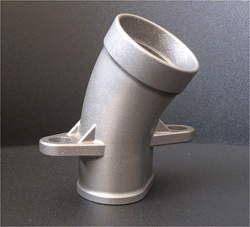
Pipe made from steel powder using selective laser melting. (Via: crptechnology.com)
Another form of 3D printing is multi-jet modeling. It builds objects from layers of powder, too, but uses an inkjet print head to instead spray a binder solution which glues the granules together. Some printers can spray up to four different colors of binder solution, which allows them to create full-color, 3D objects.
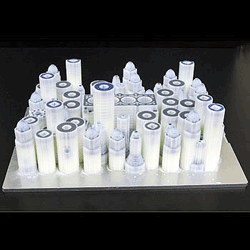
Intricate model created using multi-jet modeling. (Via: makepartsfast.com)
There’s also fused deposition modeling. This process involves a hot thermoplastic (the same type used in traditional injection molding) that gets extruded from a temperature-controlled print head. It’s capable of producing robust objects with remarkable accuracy.
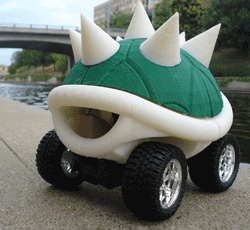
Koopa shell created using fused deposition modeling. (Via: honeybuild.com)
2. Current applications
With the need for rapid product prototyping (like producing molds), a majority of 3D printers are used for commercial manufacturing. It’s a terrific alternative, especially when producing models that feature complex curves (which require a ton of time and can be quite expensive, too).
3D printers allow engineers to check the fit of different parts before committing to production. It also allows architects to show clients detailed, yet low-cost, small-scale models, and archaeologists to handle full-scale copies of bones.
One field that has really taken to 3D printing is healthcare. This is especially true in dentistry, where tech-savvy dental technicians are already using this technology to create crowns, bridges, and temporary teeth.
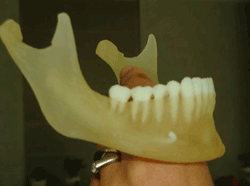
3D-printed teeth sitting in model. (Via: perspectives.3ds.com)
Hearing-aid manufacturers have hopped on the bandwagon, too, with printers capable of producing ear molds and shells unique to their customers.
Other areas of manufacturing that employ 3D printing include automobiles, jewelry, lighting, furniture, toys, and packaging.
3. Companies already in the mix
There are already a bunch of companies that offer 3D printing. The difference between all of them is the way in which they build the layers to create parts. As discussed earlier, there are several methods to choose from, and each has its advantages and drawbacks when it comes to speed, cost, materials, and color capabilities. Depending on what you need to manufacture, one printer may be better than the other.
Printers range in size, too, from kit-built tabletop models to full-scale commercial printers capable of manufacturing the body of a small car. Well-established 3D printer manufacturers include 3D Systems, Stratasys, Fortus 3D Manufacturing Systems, Solidscape, ZCorp, and envisionTEC.
2D printers have gotten in on the 3D mix, too. Case in point: Hewlett Packard sells the fused deposition modeling-based HP Designjet 3D printer (in partnership with Stratasys).
4. Personal use
As 3D printing becomes more streamlined, the cost of the technology continues to drop. This has resulted in it making its way into homes for personal use.
Several online communities are already devoted to this technology. Two popular sites are RepRap.org and FabatHome.org. They’re great to check out if you’re just getting into the technology. Members share tips, designs, and information on how to build a personal 3D printer.
You can also purchase a kit to build your own 3D printer. They range in price from a few hundred dollars to several thousand depending on what you’re looking to create.
5. Outlook
3D printers show tremendous promise on the commercial side, but as to whether or not they’ll ever catch on in consumers’ homes remains to be seen.
Experts do, however, foresee a day when 3D printers will be used to output a majority of the spare parts we use every day. Example: Let’s say you crack the glass in your car’s rearview mirror and the local car parts store is out of the size glass you need. Instead of driving around with a blind spot until the glass is in stock, you can just go to your local 3D printer facility with the specs for the glass and have the new mirror printed out for you right there on the spot.
Some examples where this is already taking place: The U.S. Army experimented with a truck-mounted 3D printer that could output spare tank and vehicle components. NASA, too, tried out a 3D printer and due to thes success of the program, they just announced last month an initiative to bring a 3D printer up to the International Space Station to produce spacecraft parts, astronaut tools, satellites, and more.
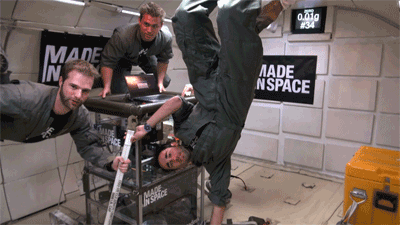
3D printer being tested in microgravity situation. (Via: madeinspace.us)
Other areas where 3D printing is being tested: A 3D printed flyable aircraft was recently created by engineers at the University of Southampton. The folks at Rolls Royce are trying the technology out, too, using it to manufacture civil aircraft engines. A team at Loughborough University is presently working on a 3D concrete printing project, with the goal being to create a machine capable of creating large building components on site, to any design, and with improved thermal properties. Also, a car has been manufactured using 3D printing. Code-named “Urbee,” the effort was taken on by two groups: Kor Ecologic and Stratasys. The result was the first-ever vehicle to have its entire body, including glass panels, manufactured using 3D printing.
There’s also the developing field of bioprinting (covering this would be a whole other article.) The general idea here is that hospitals could one day use 3D printing to manufacture replacement organs for the human body. It has received a tremendous amount of funding so far and the field as a whole has seen rapid development in recent years.
Conclusion
On-demand 3D printing for the general consumer won’t be ready for some time. The good news, though, is that the path to getting there is laid out. In fact, this year the United States’ Defense Advanced Research Projects Agency plans to put 1,000 production-quality 3D printers in high schools all across the U.S. as part of its Manufacturing Experimentation and Outreach effort. So, if there’s not already one nearby, chances are there will be a 3D printer coming to your neighborhood pretty soon.
References for this article via:
Advertisement
Learn more about Electronic Products Magazine





